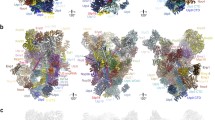Abstract
Free 80S ribosomes of eukaryotic organisms are dissociated by KCl (0.8–1.0 m) in the presence of 2-mercaptoethanol and magnesium ions (10–15mm); the large and small subunits so formed can be recombined to yield 80S monomers. We have now studied the ability of ribosomal subunits from protozoa (Tetrahymena pyriformis), fungi (Allomyces arbuscula, Saccharomyces cerevisiae), plants (pea, wheat), and mammals (rat, mouse, rabbit) to combine to form hybrid ribosomes. In general, both subunits of the species studied participate in the formation of hybrid particles, with the exception of the 60S subunit of Tetrahymena, which does not combine with the small subunit of fungal, plant, or mammalian ribosomes. The interaction of subunits from rat and Tetrahymena ribosomes has been visualized by an electron microscope study of negatively stained preparations. The base sequences of the ribosomal RNAs of these organisms have been compared to those of Saccharomyces by nucleic acid hybridization-competition.
Similar content being viewed by others
References
Bayley, S. T. (1964). Physical studies on ribosomes from pea seedlings. J. Mol. Biol. 8 231.
Bicknell, J. N., and Douglas, H. C. (1970). Nucleic acid homologies among species of Saccharomyces. J. Bacteriol. 101 505.
Chang, F. N., Sih, C. J., and Weisblum, B. (1966). Lincomycin, an inhibitor of aminoacyl sRNA binding to ribosomes. Proc. Natl. Acad. Sci. 55 431.
Church, R. B., and McCarthy, B. J. (1968). Related base sequences in the DNA of simple and complex organisms. II. The interpretation of DNA/RNA hybridization studies with mammalian nucleic acids. Biochem. Genet. 2 55.
Click, R. E., and Hackett, D. P. (1966). The isolation of ribonucleic acid from plant, bacterial or animal cells. Biochim. Biophys. Acta 129 74.
Denhardt, D. T. (1966). A membrane-filter technique for detection of complementary DNA. Biochem. Biophys. Res. Commun. 23 641.
Huxley, H. E. (1963). Electron microscope studies on the structure of natural and synthetic protein filaments from striated muscle. J. Mol. Biol. 7 281.
Huxley, H. E., and Zubay, G. (1960). Electron microscope observations on the structure of microsomal particles from Escherichia coli. J. Mol. Biol. 2 10.
Lederberg, S., and Lederberg, V. (1961). Hybridization between bacterial ribosomes. Exptl. Cell Res. 25 198.
Lederberg, S., and Mitchison, J. M. (1962). Interaction of the ribosomes of Schizosaccharomyces pombe and Escherichia coli. Biochim. Biophys. Acta 55 104.
Loening, U. E. (1968). Molecular weights of ribosomal RNA in relation to evolution. J. Mol. Biol. 38 355.
Martin, T. E., and Wool, I. G. (1968). Formation of active hybrids from subunits of muscle ribosomes from normal and diabetic rats. Proc. Natl. Acad. Sci. 60 569.
Martin, T. E., and Wool, I. G. (1969). Active hybrid 80S particles formed from subunits of rat, rabbit and protozoan (Tetrahymena pyriformis) ribosomes. J. Mol. Biol. 43 151.
Martin, T. E., Rolleston, F. S., Low, R. B., and Wool, I. G. (1969). Dissociation and reassociation of skeletal muscle ribosomes. J. Mol. Biol. 43 135.
Moore, R. L., and McCarthy, B. J. (1967). Comparative study of ribosomal ribonucleic acid cistrons in enterobacteria and myxobacteria. J. Bacteriol. 94 1066.
Parisi, B., Milanesi, G., Van Etten, J. L., Perani, A., and Ciferri, O. (1967). Species specificity in protein synthesis. J. Mol. Biol. 28 295.
Petermann, M. L. (1964). The Physical and Chemical Properties of Ribosomes, American Elsevier Publ. Co., New York.
Shelton, E., and Kuff, E. L. (1966). Substructure and configuration of ribosomes isolated from mammalian cells. J. Mol. Biol. 22 23.
Stutz, E., and Noll, H. (1967). Characterization of cytoplasmic and chloroplast polysomes in plants: Evidence for three classes of ribosomal RNA in nature. Proc. Natl. Acad. Sci. 57 774.
Takeda, M., and Lipmann, F. (1966). Comparison of amino acid polymerization in B. subtilis and E. coli cell-free systems: Hybridization of their ribosomes. Proc. Natl. Acad. Sci. 56 1875.
Taper, H. S., Woolley, G. W., Teller, M. N., and Lardis, M. P. (1966). A new transplantable mouse liver tumor of spontaneous origin. Cancer Res. 26 143.
Tissières, A., Schlessinger, D., and Gros, F. (1960). Amino acid incorporation into proteins by Escherichia coli ribosomes. Proc. Natl. Acad. Sci. 46 1450.
Author information
Authors and Affiliations
Additional information
This work was supported by a fellowship #PF-529 from the American Cancer Society and by United States Public Health Service, National Institutes of Health grant GM 12449.
Rights and permissions
About this article
Cite this article
Martin, T.E., Bicknell, J.N. & Kumar, A. Hybrid 80S monomers formed from subunits of ribosomes from protozoa, fungi, plants, and mammals. Biochem Genet 4, 603–615 (1970). https://doi.org/10.1007/BF00486098
Received:
Revised:
Issue Date:
DOI: https://doi.org/10.1007/BF00486098




